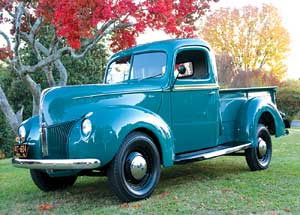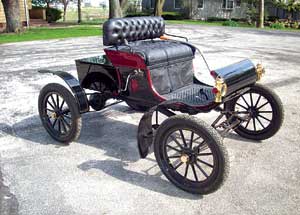Editorial
Front Page - Friday, May 14, 2010
Antique car collectors preserving history along with automobiles
David Laprad
 A 1940 Ford truck owned by Hamilton County General Sessions Court Judge Bob Moon. He plans to enter the vehicle in a competition in June in a bid to win the Senior Grand National Award, the highest honor the Antique Automobile Club of America bestows.
- Photo provided
A 1940 Ford truck owned by Hamilton County General Sessions Court Judge Bob Moon. He plans to enter the vehicle in a competition in June in a bid to win the Senior Grand National Award, the highest honor the Antique Automobile Club of America bestows.
- Photo provided
General Sessions Court Judge Bob Moon appreciates fine art. But the objects of his affection can’t be found hanging on the walls of a museum. That’s because Moon admires 1940 Ford automobiles.
 A 1903 Oldsmobile Curved Dash Roundabout owned by Antique Automobile Club of America executive director Steve Moskowitz. - Photo provided
“A lot of things happened in 1940,” Moon says. “That was the first year Ford had sealed headlights, hydraulic brakes and wipers at the bottom of the windshield instead of the top. It was also the first year Ford put the transmission on the column instead of the floor. Women loved that. They liked being able to sit next to their man.”
The judge has purchased six 1940 Fords since he began collecting in the early ’90s. The walls and shelves of his chambers contain a small museum’s worth of photos of his acquisitions, small models, dozens of national awards and his credentials as an Antique Automobile Club of America and Early Ford V-8 Club judge.
Moon is far from alone in loving antique cars: the AACA has approximately 60,000 members and hosts well over a dozen highly attended national events.
The judge offers a number of reasons why people are drawn to antique cars, including the aesthetic appeal of classic vehicles and reasons more personal.
“The look of a 1940 Ford Coupe is without comparison,” he says. “There’s the sloping back, the weeping headlights, the chrome grill and the Chevron tail lights. The real beauty of that car, though, is found in the independent fenders and running boards. When they took those away, cars started to look pretty much the same.”
Moon’s fondness for ‘40 Fords began with his father, who loved the vehicles and often traveled to Dearborn, Mich., with a friend to purchase a pair for resale locally. Today, the automobiles are a point of remembrance for the judge, who thinks of his father and the positive influence the man had on his life every time he receives a new award.
“I don’t believe there’s such a thing as a self-made man. There are men who are what they are because of what others have done for them,” he says. “And there’s nothing good that’s ever happened to me that I can’t trace back to my parents.”
The nostalgia that runs through the blood of classic car collectors such as Moon fuels a deep respect for the vehicles, which in turn motivates a zeal for authenticity when restoring and preserving a vehicle. To a collector striving to make an automobile worthy of competing at the national level, no detail is too small to get right.
“It’s all about getting back to what the car looked like the day it rolled off the showroom floor,” Moon says. “But that’s not easy to do. It might take you a few months to find the correct shocks and a year to find the right cigarette lighter.”
Not only that, but some parts are becoming increasingly rare as the years pass. The heater Ford used in its 1940 models is still easy to find, Moon says, but the switch for the heater isn’t.
And if the owner of an antique car thinks the judges at a national meet will overlook a tiny deviation, he’ll quickly find out he’s wrong. As someone who’s completed 24 judging classes and won every possible award except one for the classic vehicles he owns, Moon says nothing escapes the sharp eyes of an AACA or Ford V-8 Club judge.
“Separate judges evaluate different areas,” he says. “One will look at the interior, another will inspect the undercarriage and still another will examine the engine. They’ll check to see if the screws holding down the package tray have a black finish, and they’ll take off points if they don’t.”
For the owner of a car to bring his vehicle up to that level, he must either have extensive knowledge of his particular automobile or know how to tap into the network of like-minded individuals for the information he needs. When it comes to ‘40 Fords, Moon is a reservoir of facts; he’s even spotted bad information other car collectors missed for years.
“Manufacturers were reproducing the wrong horn button,” he says. “People were putting ‘41 through ‘46 buttons, which had the Ford script and a triangle, in their ‘40 trucks. But when I went to the archives, I discovered that the ‘40 button had a ‘V’ and then an ‘8’ on it.”
Moon submitted his finding to a manufacturer, who made 100 of the right horn buttons. The parts have since sold out.
While accuracy has its rewards, it also comes with a price. A tire for a ‘40 Ford alone costs over $500, which is more than the entire car cost new back in the day. Not only that, but as original parts grow scarce, prices go up. Add the expense of paying a professional to restore an automobile, and Moon says someone could spend more money renovating a car than it would never be worth in their lifetime.
While the hit to the wallet can be severe enough to ward off casual hobbyists, it’s not a deterrent to hard-core devotees. A leading auction house recently handled $45 million in antique car sales in a single day, establishing a new one-day record, Steve Moskowitz, executive director of the AACA, says.
Moskowitz also says there are lower entry points for people who are interested in antique cars but can’t afford the cost of restoring an automobile to national standards. “You can buy an inexpensive car and still have a blast,” he says. “There are a lot of affordable cards out there, and if you do some of the work yourself, it makes the expense even more palatable. This doesn’t have to be a rich man’s hobby.”
Moon says a person who wants to start collecting antique cars should first decide whether he wants to drive his car or show it. “You can’t do both,” he says. “If you drive it, you’re going to sling oil, the engine’s going to heat up and things are going to get used. If you compete with an automobile in that condition, you’re going to lose points.”
The next step would be to talk with an experienced collector. “Some of the most knowledgeable antique automobile collectors in the world live in Chattanooga,” Moon says. “I’ll always be grateful to (former Hamilton County commissioner) Harold Coker and (attorney) Jerry Summers for sharing their wealth of knowledge with me.”
The aspiring hobbyist must then find an automobile that appeals to him. Since the AACA allows all makes and models 25 years or older to compete, locating a vehicle with sentimental value shouldn’t be hard. “As America grows older, the next generation is going to want the things they drove in high school,” Moon says. “So the trend of the 21st century will be the fast and heavy American muscle cars: the Barracudas, the Plymouth Roadrunners and the GTOs.”
Moskowitz simply hopes the next generation of antique car enthusiasts will do their part to preserve history. “Losing our past would change the fabric of our lives,” he says. “The automobile has had a major impact on the formation of our country. Cars tell a huge social story while making people smile and enjoy bygone eras.”
|
|